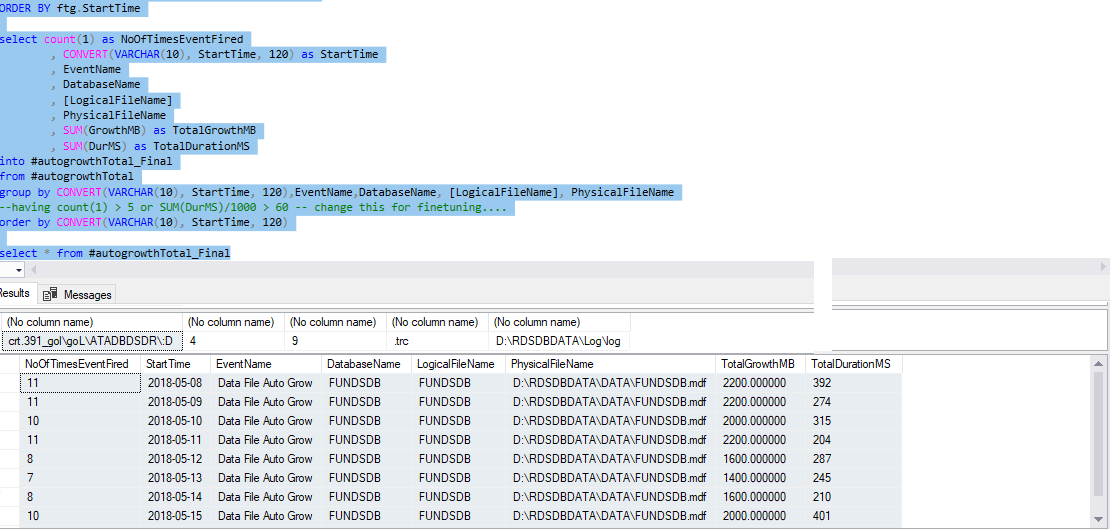You are most likely looking into somethng known as default trace, a light weight trace that runs in the background when SQL Server starts. To see if default trace is enabled:
SELECT value_in_use
FROM sys.configurations
WHERE configuration_id = 1568 /* 1 indicates the trace is enabled */
To view the location of trace files:
SELECT REVERSE(SUBSTRING(REVERSE(path), CHARINDEX('\', REVERSE(path)), 256)) AS DefaultTraceLocation
FROM sys.traces
WHERE is_default = 1
You will find four trace files here, and each files are about 5 mb in size. When all four files are full, it rolls over (removes the oldest file from the disk) and a new trace file is created. Therefore, you might not be able to keep track of older data unless you siphon it off to a customized table somewhere.
You can view auto growth setting for your current trace file using:
/*Author - Feodor Georgiev*/
SELECT TE.name AS [EventName] ,
T.DatabaseName ,
t.DatabaseID ,
t.NTDomainName ,
t.ApplicationName ,
t.LoginName ,
t.SPID ,
t.Duration ,
t.StartTime ,
t.EndTime
FROM sys.fn_trace_gettable(CONVERT(VARCHAR(150), ( SELECT TOP 1
f.[value]
FROM sys.fn_trace_getinfo(NULL) f
WHERE f.property = 2
)), DEFAULT) T
JOIN sys.trace_events TE ON T.EventClass = TE.trace_event_id
WHERE te.name = 'Data File Auto Grow'
ORDER BY t.StartTime
You can also pull the data from previous trace files by slightly modifying the previous query.
SELECT TE.name AS [EventName] ,
T.DatabaseName ,
t.DatabaseID ,
t.NTDomainName ,
t.ApplicationName ,
t.LoginName ,
t.SPID ,
t.Duration ,
t.StartTime ,
t.EndTime
FROM sys.fn_trace_gettable(CONVERT(VARCHAR(150), ( SELECT REVERSE(SUBSTRING(REVERSE(path),CHARINDEX('\',REVERSE(path)),LEN(path)))+'log.trc'
FROM sys.traces
WHERE path LIKE '%\MSSQL\Log\log%.trc'
)), DEFAULT) T
JOIN sys.trace_events TE ON T.EventClass = TE.trace_event_id
WHERE te.name = 'Data File Auto Grow'
ORDER BY t.StartTime
An example on how to load this data into a table
CREATE TABLE [dbo].[DefaultTrace_History](
[Id] [bigint] IDENTITY(1,1) NOT NULL,
[instancename] [nvarchar](256) NOT NULL,
[EventName] [nvarchar](128) NOT NULL,
[DatabaseName] [nvarchar](256) NOT NULL,
[DatabaseID] [int] NOT NULL,
[NTDomainName] [nvarchar](256) NULL,
[ApplicationName] [nvarchar](256) NOT NULL,
[LoginName] [nvarchar](256) NOT NULL,
[SPID] [int] NOT NULL,
[Duration] [int] NOT NULL,
[StartTime] [datetime] NOT NULL,
[EndTime] [datetime] NOT NULL,
[GrowthInMB] [decimal](5,2) NOT NULL,
[FileName] [nvarchar](256) NOT NULL
) ON [PRIMARY]
GO
Procedure to load the data incrementally:
CREATE OR ALTER PROCEDURE [dbo].[SP_Load_DefaultTrace_History]
AS
DECLARE @maxdt DATETIME
DECLARE @sql NVARCHAR(max)
SELECT @maxdt = max(starttime)
FROM [DefaultTrace_History]
SET @sql=
N'INSERT INTO [DefaultTrace_History] (InstanceName,EventName,DatabaseName,DatabaseID,NTDomainName,ApplicationName,LoginName,SPID,Duration,StartTime,EndTime,GrowthInMB,FileName)
SELECT @@servername,
TE.name AS [EventName] ,
T.DatabaseName ,
t.DatabaseID ,
t.NTDomainName ,
t.ApplicationName ,
t.LoginName ,
t.SPID ,
t.Duration ,
t.StartTime ,
t.EndTime,
convert(decimal(19,2),t.IntegerData*8/1024) AS GrowthInMB,
smf.physical_name AS [FileName]
FROM sys.fn_trace_gettable(CONVERT(VARCHAR(150), ( SELECT REVERSE(SUBSTRING(REVERSE(path),CHARINDEX(''\'',REVERSE(path)),LEN(path)))+''log.trc''
FROM sys.traces
WHERE path LIKE ''%\MSSQL\Log\log%.trc''
)), DEFAULT) T
JOIN sys.trace_events TE ON T.EventClass = TE.trace_event_id
JOIN sys.master_files smf ON smf.database_id = t.DatabaseID
WHERE te.name = ''Data File Auto Grow'''
IF (SELECT count(1)
FROM [DefaultTrace_History]
WHERE instancename = @@servername) = 0
BEGIN
EXEC sp_executesql @sql
END
ELSE
BEGIN
SET @sql= @sql + ' AND @@servername = @@servername AND t.StartTime >' + quotename(convert(VARCHAR(25), @maxdt, 121),'''') + ' ORDER BY t.StartTime DESC'
EXEC sp_executesql @sql
END
--Purge records > 365 days
DELETE FROM [DefaultTrace_History] WHERE [instancename] = @@servername AND [StartTime] < dateadd(dd,-365,getdate())
GO
You can then create a job to run on a schedule to load the data.

